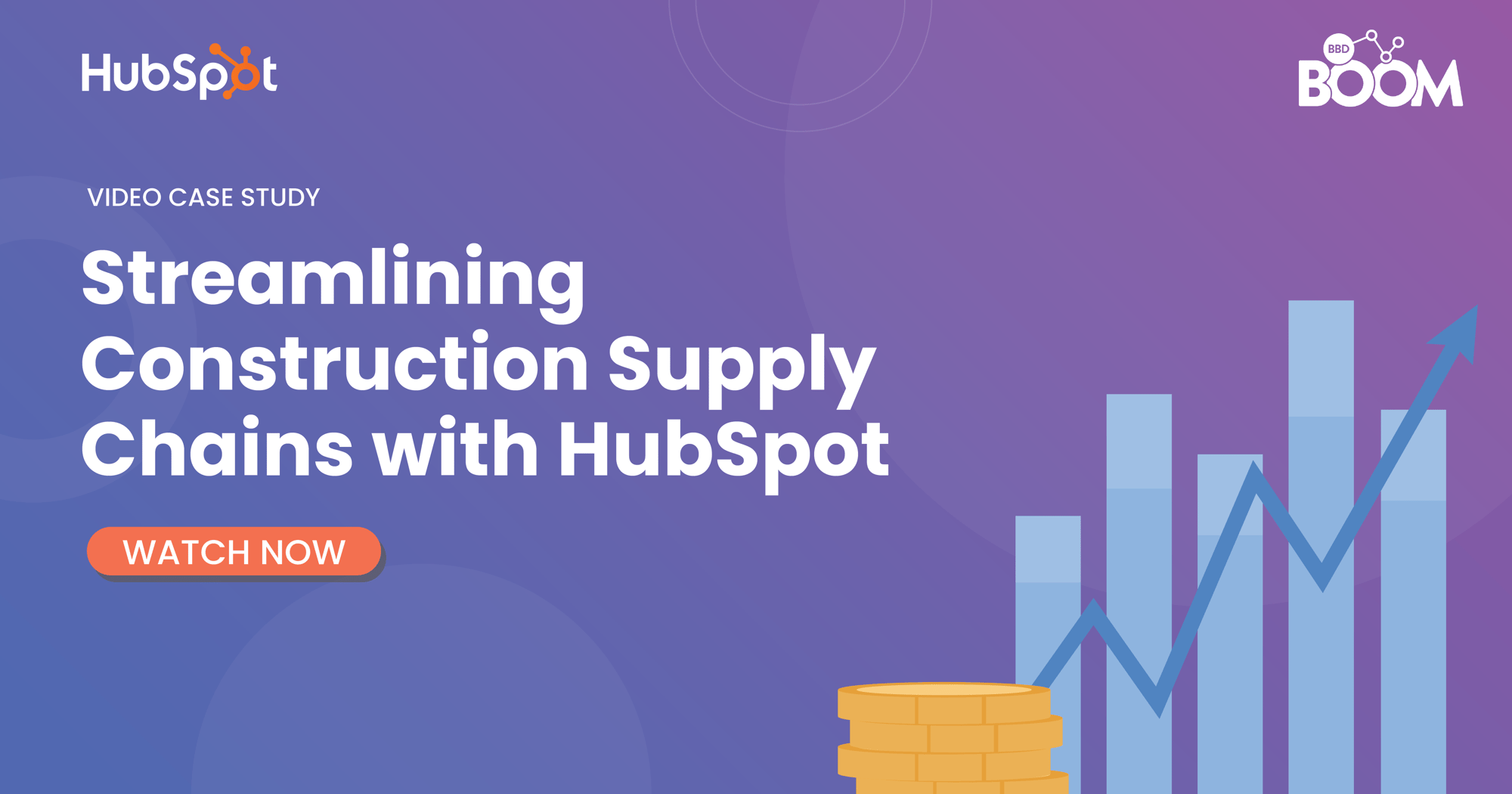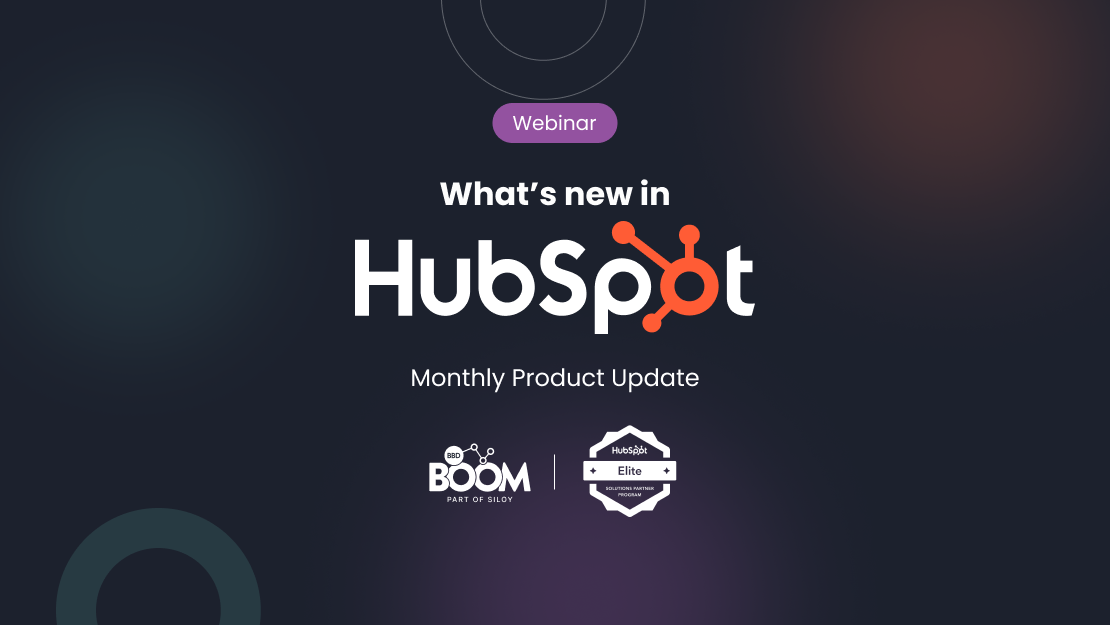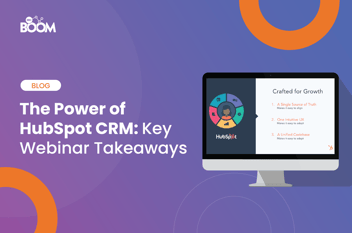Back in March, we wrapped up one of our latest Growth Webinars that focused around the discussion of how you can get off to a flying start with HubSpot. Everything mentioned within this blog is a recap from the webinar.
This blog is the perfect resource for those who are new to HubSpot, or for those who are considering purchasing HubSpot as it aims to answer all of those important questions you have when starting out on your journey.
Within this blog, you will find recommendations both from Angelo Norton, Program Manager at HubSpot and Sam Gale, Client Success Director at BBD Boom. These two individuals are experts in onboarding clients to the HubSpot platform. Information from this document has been cited from one of our B2B Growth series webinar, How to get off to a flying start with HubSpot. Click here if you’d like to watch the recording.
Know what HubSpot onboarding is
What is onboarding?
Onboarding is a guided consultation for all new clients to help them work towards their set goals with HubSpot. They are usually for a set amount of time and the aim is to help fast track clients to their HubSpot use cases.
What is the purpose of onboarding?
The purpose of onboarding is to reduce time to value for clients and alleviate frustrations from the beginning to help you succeed in your HubSpot journey. Sometimes, you can have a bad experience when you don’t have the help from the outset, as you are left to your own devices, where you can end up spending too much time trying to figure out all the basic functions of HubSpot
What is the value of onboarding?
Onboarding is about taking a simple tool and applying it to use cases that are more difficult. This is done by making sure the tool is being used and adapted in a way that will best serve your business. HubSpot tools can do sophisticated things and when they are used well, it will help to serve those business specific use cases.
An advantage of onboarding is that it involves practical implementation, meaning you can learn hands on, resulting in you being self-sufficient by the end of it. However, onboarding isn’t just training you on HubSpot, as there are several other assets you can do instead of just training.
Know the difference between HubSpot and Partner onboarding
What is a guided HubSpot onboarding?
The purpose of a guided HubSpot Onboarding is for the client to implement the tools themselves, whilst HubSpot consults and ensures they apply it in the right direction. The aim is to help build their pipeline within 90 days. The cadence of calls are dependent on the client; either once a week or once every two weeks.
What is Partner onboarding?
A Partner onboarding is where a HubSpot Partner, like Boom, would do the implementation and action everything for the client, making sure they are involved and in the loop the entire process. This onboarding will only be 60 days and your partner would make sure to carefully scope the use cases, understanding the team's capabilities and recommending the correct set up of tools.
The ultimate aim is to make sure the clients has a return on tech investment, as clients always want to see the value of HubSpot from the very beginning. During a partner onboarding, clients will also be trained on the tools, so you are still aware of what everything is and how to use it.
What is the difference between them?
Both of these approaches to onboarding are valuable and strategic, but the main difference is that with a HubSpot guided onboarding, the client does the implementation. For a Partner Onboarding however, it is your Partner who will do the implementation.
What are the relevant use cases for both?
A use case for the HubSpot guided Onboarding might be that the client has the time to implement everything, therefore they can do it themselves with consultation. Whereas, the use case for the Partner Onboarding would be where they might need us to do them.
Know who needs to be involved in the onboarding process
Who are the main people to involve?
The most obvious people to involve would be anyone who’s going to be using HubSpot. This depends on your objectives and what you want to achieve, so you’ll need to involve those who are relevant to the subject matter and use case.
Other people who you may want to involve would be the people who manage your website but aren’t in the marketing department. This is because there are basic things that need to be set up in order to allow the marketer to use the other tools. These people will need to come onto the first call.
Why is it important to find the decision maker?
It is important to make sure you have a point of contact. This is so they’re able to manage the product and be able to delegate from beginning to end. They will also know the team well and who is involved with what, so they are entrusted to make decisions on who works on what.
When should you introduce new users?
You should introduce new users when you feel it is the right time. In most cases, this will be once the basic things have been set up so it’s usable for the new users. This will depend on your use cases as it could be sooner or later.
Know how to overcome challenges when starting out
Why should I learn to walk before I start running?
You need to follow the trusted process that your onboarding partner lays out for you, as all of the tools link to another tool and that is why they are done in the format that they are. Don’t dive head first, as you may feel overwhelmed, causing friction between teams if you don’t know what to do. Make sure you lean on your onboarding specialist. They’re there to help you for a reason!
Why should I trust the process?
Your Partner will get you to where you need to be; one step at a time. The menial tasks are meant to be done; they’re working with you, not against you. Remember that they’re challenging you because they want you to succeed!
Why should I come prepared?
The general set up tasks need to be done because they can hold up fundamental actions like email marketing or the ability to create landing pages. Therefore, come prepared and do your homework so you can get started on the fun stuff quicker. These tasks are in that order for a reason.
Know HubSpot's capabilities in customisation
What does HubSpot offer in terms of customisation?
HubSpot is not a web design agency, so they cannot create any customised things themselves. However, they have templates in the marketplace that have already been created, and you can migrate your current website’s templates to HubSpot.
When should I involve a third party for customisation?
If there aren't any templates in the marketplace that are similar to what you wanted, or if you aren’t able to migrate your templates, then you should consider involving a third party. More customisation will involve coding and third parties such as HubSpot partners. With their expert HubSpot developers, they can help you customise your content so it is uniform with your brand.
Can a partner onboarding help with customisation?
A partner onboarding can help. An agency like BBD Boom can build wireframes to the relevant use case and can work together with you to scope it out, making sure that the functionality is exactly what it needs to be.
Know how to handle your data
How can HubSpot help you manage your data?
HubSpot will not just add your data to your CRM, as that would be bad data protection. However, if it’s just a straight forward export then they can do a session on it during your onboarding to help you.
What are my options with partners for managing data?
Like HubSpot, a partner would not just add the data for you, however, you can get an integration based data transfer through APIs. Or, once your system is set up, a spreadsheet template can be created with the correct properties and dropdown values set up. This can then be sent to you, so you can adapt your data and upload it to HubSpot yourself.
How should my data look before starting on HubSpot?
Ultimately, your data should be cleansed before starting on HubSpot. You’ll need to make sure all of the email addresses associated with your contacts are correct and that they are still working at the company associated with them.
Know your support when onboarding
What resources can a HubSpot guided onboarding offer?
Your CSM is a very important resource when onboarding. They will work as a strategic point of contact for you but after the onboarding, the calls will be on an adhoc basis rather than your weekly or fortnightly calls. Another good resource is the Technical support team who can assist you with all of your tech queries.
What resources can a Partner onboarding offer?
You still have access to a CSM like in the HubSpot onboardings, so make sure to utilise them. Another resource you’ll have access to is integrations which were mentioned earlier on in this playbook. Some of the various other resources range from just strategic advice, to support packages, to multiple sector experience, and if we find a need, they can provide further services off the back of the onboarding.
What resources are available within HubSpot to help along the way?
Some resources that are available for you is the HubSpot Academy, which has lots of educational, industry recognised courses to help you learn everything you need to know about HubSpot. There are also webinars hosted by HubSpot’s leading experts, and there is a Pro Services team if you’re looking for a more hands-on consulting experience.
How can integrations help?
By choosing tools that are going to integrate natively, they can complement your HubSpot usage and help you get the most out of HubSpot. If you’re interested in integrations, then we suggest downloading our complete guide to HubSpot Integrations here.
Know what happens down the line after onboarding
What should I expect after basic configuration in the onboarding process?
You will want to review some of the tools that are set up at the beginning of your onboarding. For example, reporting, as the metrics you were using may have changed as you’ve grown, and your requirements too. For example, automations may need to be altered as you might need to add in different triggers etc. Remember to utilise your CSM - they are there to help you
What are some best practices for continuity?
HubSpot is a platform that shines when it has insights to optimise, so make sure to keep track of the machine as a whole. Use folders or flow charts to make a masterplan and watch over it in HubSpot so you don’t result in any loose ends. Another suggestion is to look at your insights on a regular basis so you can implement changes when necessary. The last two practices are: make a feedback loop - this will help move things forward quicker and this will benefit your whole organisation, and make sure to mark prospects as qualified if your team wants to actually speak to them - this will save a lot of time.
As a Diamond HubSpot Agency, with over 120 HubSpot Onboarding projects under our belt, we are experts on how to get started using HubSpot the right way.
If you need any help with HubSpot, regardless of whether you’re looking to buy HubSpot or if you’ve already started on your HubSpot journey, click here to book a meeting with our Growth Consultant, or get in touch with us here.
.png?width=877&height=508&name=bbd-boom-siloy-navy+blue-logo%20(1).png)
.png)




.jpg)

.png?width=352&name=Resource%20(5).png)

